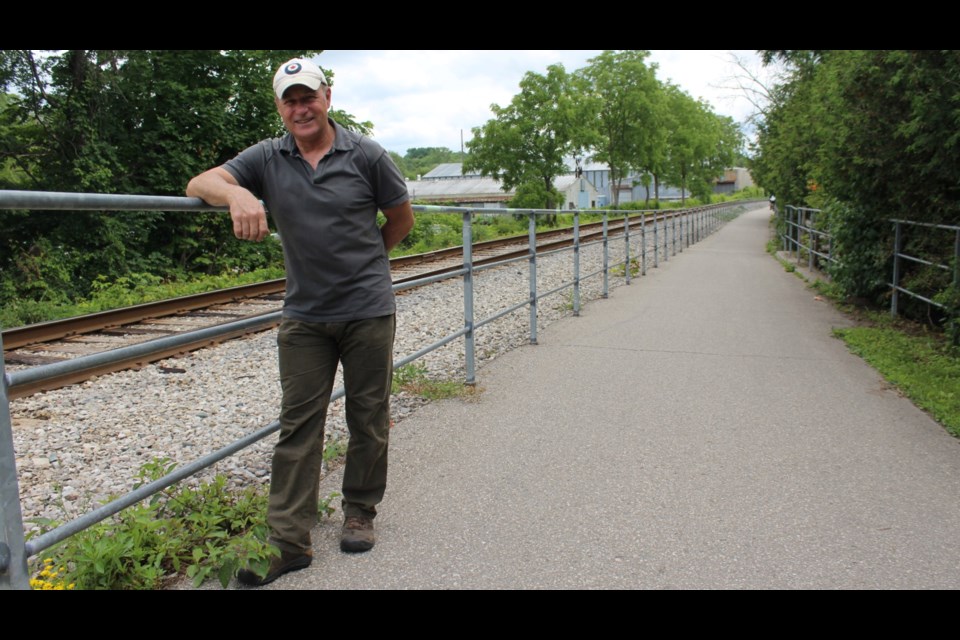Advocates are growing frustrated by inaction, and believe the city is missing out by not linking the Guelph to Goderich (G2G) rail trail to Downtown Guelph.
"People are looking at a little project. We see it as much bigger than that," said Lorenz Calcagno, the spokesperson for the Guelph portion of the G2G.
"You have an entire network of a trail system that is completed and in place, and it just doesn't have the gateway section completed, which is Guelph. Some of it is, it's just the missing three kilometres in the middle that make it completely useless to get to the Guelph to Goderich trailway inside Guelph."
What they want is to fill the gap. Right now, there is a consistent trail from the covered bridge at The Boathouse to Speedvale Avenue East, just east of Woolwich Street.
Afterwards, trail users must use Guelph roadways to get to the trailhead at Silvercreek Parkway, north of the city.
Some just choose to start at the trailhead, bypassing the city entirely, which Calcagno said is a problem.
He was one of a handful of delegates to speak to the gap at Wednesday's Committee of the Whole meeting, calling for the project to be included in the multi-year budget.
The delegates spoke during a conversation about the future strategic plan.
Mayor Cam Guthrie said a conversation about something to be added in the multi-year budget should be discussed at budget time.
Calcagno said for cyclists and hikers alike, it's dangerous having to use roadways to get between the gaps.
"Not only is it dangerous, it's perceived as undesirable and people won't do it." he said.
"What we're getting is from that danger, real or perceived, people are not starting in Guelph. They will leave Guelph, and start up at Silvercreek, which is missing Guelph entirely."
From that, Calcagno added Guelph is missing out on the economic benefits of having people using a trail all the way to the downtown, a lengthy trail he believes gets 400,000 users a year.
He adds the number could be much higher with a completed trail, and could be marketed as an overnight experience in Guelph to begin a biking weekend.
Calcagno said the largest population cohort "with all the money," the baby boomers who have homes paid off and pensions, are mostly retired and want to stay active.
"By and large, their knees aren't great and they like to ride bikes," he told the committee meeting Wednesday.
"They don't like traffic, and they're not fond of hills. They're vacationing and touring around, visiting interesting places and spending their money. Rail trails are full of grey haired people who have no problem getting a comfy room and a lovely dinner before heading out again the next day.
"Guelph is missing out on all of that."
The optimal route would, for the most part, run alongside existing train tracks.
Calcagno said live tracks shouldn't be a deterrent to finishing a trail system because there already exists a trail beside train tracks in the core of the city.
"It functions just fine," he said. "And if you look at heat maps of use, it's one of the busiest routes in Guelph for active transportation, that corridor. Makes sense, it's away from vehicles, it's right down the centre of town, it gets a lot of use."
The tracks are owned by Guelph Junction Railway (GJR), who needs to be an active participant in all this, according to John Fisher, the president of the Guelph Hiking Trail Club.
The GJR's latest annual report does discuss trail connectivity as part of its ongoing projects and opportunities.
"The GJR plans to do a complete rail line over between Woodlawn Road and at its end of track in 2023, which will create space for a potential future trail if deemed safe by relevant authorities," the report states.
Fisher said the "historic, informal trailway pedestrians and cyclists used to use to access the G2G is closed" because the "GJR (is) installing rail infrastructure for a new transloading customer."
He said a safe G2G connection is critical now, and the GJR has a responsibility to city taxpayers to complete grading and connectivity improvements, which he said is a prerequisite to building a new trail.
He's also calling on the parks department to complement the construction timeline, "which means it must be included in the upcoming multi-year-budget."
It's not like the topic is new. The project has been in the city's trails master plan since 2005, and was most recently identified as the top city trail building project in the 2021 plan.
However, advocates say despite this, there's been little progress.
"For less than the price of a soccer field or a baseball diamond, this project can be completed," Calcagno told committee members.
"Out of almost 150 kilometres, we're the last three kilometres that's not done. Every community along the way has managed to get it, and do it, and install it, and finish it, except us.
"For three kilometres. That's all we're talking."
